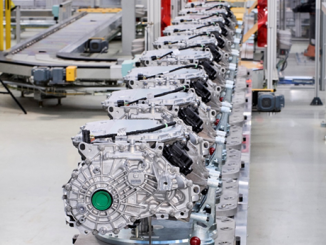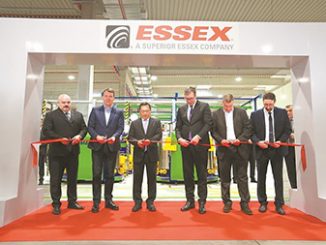By Meriem Akin, Lutz Rissing | Institute of Micro-Production Technology
Computerizing information has enabled paper to dissociate itself from being merely a passive carrier for ink. Due to its unique technical properties (such as light weight, mechanical bendability, porosity, moisture intake, chemical resistivity, thermo-mechanical stability), low cost and resource abundance, disruptive technology based on paper has emerged in the past 10 years: medical diagnosis systems, interactive displays, foldable microscopes, robust civil architecture and pulp-based computing to name a few [1-5].
 At the Institute of Micro-Production Technology, we research the fabrication of micro-electro-mechanical systems based on paper, and we exploit clean room fabrication processes (Figure 1) for manufacturing these systems. Currently, we research the use of paper as an interposer for magnetic coatings. In particular, we want to understand the magnetic response of a wide range of magnetic materials (ferri-, ferro and antiferromagnetic) when deposited onto paper substrates.
At the Institute of Micro-Production Technology, we research the fabrication of micro-electro-mechanical systems based on paper, and we exploit clean room fabrication processes (Figure 1) for manufacturing these systems. Currently, we research the use of paper as an interposer for magnetic coatings. In particular, we want to understand the magnetic response of a wide range of magnetic materials (ferri-, ferro and antiferromagnetic) when deposited onto paper substrates.
While we use paper as a surface carrier for thin layers of magnetic materials, the integration of magnetic materials within the body of the paper is state of the art. Magnetic papers can be realized by dip coating paper sheets into monomer solutions filled with magnetic nanoparticles [6]. Also, embedding magnetic particles during the synthesis process of cellulose allows for the fabrication of super-paramagnetic papers [7]. As a matter of fact, paper with embedded magnetic stripes is in daily use for parking garage and subway tickets, etc. However, the superficial magnetic coatings of these paper-based systems are thick enough to not interplay with the paper surface.
As yet, existing paper-based systems make use of binary magnetic phenomena. By depositing magnetic silicones onto paper-based cantilevers, the resulting valve can open and close to control the fluid flow in lab on a paper [8]. A further example is paper actuators that are fabricated by impregnating paper with a ferrofluid and subsequent laser machining to the desired geometry [9].
Ergo, would it be possible to insert more intricate magnetic phenomena, such as spintronic effects (anisotropic, giant or tunnel magneto-resistance) on a sheet of paper? And, how could we exploit these phenomena in engineering unorthodox paper-based devices for leisure, medical and educational use? These are some of the questions that we tackle at the Institute of Micro Production Technology.
 Exploratory Study
Exploratory Study
We believe that the network topology of paper is decisive for the magneto-resistive response of a continuous thin deck of a magnetic material when deposited onto paper substrates (Figure 2). Due to the non-planar and stochastic orientation of the paper fibers, each local fiber region exhibits a different direction of electrical current with respect to the direction of the magnetic field. One may consider each fiber as a distinct thin and long magnetic stripe. Therefore, the magnetic response of a paper-based spintronic system is expected to be a complex superposition of local spintronic phenomena.
In particular, we report on our findings with Permalloy (Py:Ni81Fe19), which classically exhibits anisotropic magneto-resistance at room temperature. We opted for sputter deposition as a dry coating technique, and we chose clean room paper (latex impregnated) as the substrate material. As a reference substrate material, we used fused silica with superior surface quality. In order to separate material behavior from surface topology, we replicated the surface topology of the paper at a satisfactory fidelity onto an epoxy resin mould by vacuum casting techniques. Besides, we conducted micro-machining (cutting and dicing) of the substrates before sputter deposition, and employed low sputtering powers in order to minimize the mechanical stress within the Py:Ni81Fe19 coatings. By means of electron dispersive x-ray scanning, we verified that the composition of the sputter deposited 70 nm thick Py:Ni81Fe19 layer is similar and homogeneous on all substrate materials.
How do the substrate topology of paper affect the magnetic response of Py:Ni81Fe19? First, we characterized all three systems in a vibrating sample magnetometer. We have observed that the Py:Ni81Fe19-paper system exhibits largest coercivity and coercivity squareness and lowest remanence of all systems. While the magnetic properties of the Py:Ni81Fe19-epoxy system are close to the Py:Ni81Fe19-paper system, the Py:Ni81Fe19-paper system exhibits 65 percent more coercivity and 35 percent less remanence than the Py:Ni81Fe19-glass system.
 MOKE measurements led to the observation of distinct regions with white fibrous contrast (Figure 3) at the locations, where fibers change orientation. The white contrast is an indication for magnetic field scattering and the formation of domain walls. At these regions, electrical resistance is expected to increase. DC four-point-resistance measurements at room temperature have revealed that the Py:Ni81Fe19 coating on clean room paper exhibits an accentuated change in resistance in dependence of the strength of the magnetic field. Compared to the Py:Ni81Fe19-glass system, the peak at the zero magnetic field strength is a high and twice as wide due to larger material coercivity. Due to the combination of multitudinous fiber orientations, and therefore current directions at a measurement location, the Py:Ni81Fe19-paper and the Py:Ni81Fe19-epoxy systems do not respond distinctly different, when the direction of the magnetic field forms a different angle with the direction of the electrical current. In average, the Py:Ni81Fe19-paper and the Py:Ni81Fe19-epoxy systems exhibit the classical ±45° angle response of the Py:Ni81Fe19-glass system.
MOKE measurements led to the observation of distinct regions with white fibrous contrast (Figure 3) at the locations, where fibers change orientation. The white contrast is an indication for magnetic field scattering and the formation of domain walls. At these regions, electrical resistance is expected to increase. DC four-point-resistance measurements at room temperature have revealed that the Py:Ni81Fe19 coating on clean room paper exhibits an accentuated change in resistance in dependence of the strength of the magnetic field. Compared to the Py:Ni81Fe19-glass system, the peak at the zero magnetic field strength is a high and twice as wide due to larger material coercivity. Due to the combination of multitudinous fiber orientations, and therefore current directions at a measurement location, the Py:Ni81Fe19-paper and the Py:Ni81Fe19-epoxy systems do not respond distinctly different, when the direction of the magnetic field forms a different angle with the direction of the electrical current. In average, the Py:Ni81Fe19-paper and the Py:Ni81Fe19-epoxy systems exhibit the classical ±45° angle response of the Py:Ni81Fe19-glass system.
Currently, we are aiming at understanding the impact of these local topological phenomena on a paper-based structured thin film anisotropic magneto-resistor –from stripes to meanders-, and how the type of paper (micro- to nanopaper) and coating thickness affect the responsivity of the magneto-resistor. We will report on our findings in the near future.
Acknowledgement
This work was partially funded by the German Research Foundation. We would like to acknowledge Rudolf Schaefer and Stefan Pofahl from the Leibniz Institute of Solid State and Materials Research Dresden for their assistance with the MOKE measurements.
References
[1] A. W. Martinez, S. T. Phillips, M. J. Butte and G. M. Whitesides, “Patterned paper as a platform for inexpensive, low-volume, portable bioassays,” Angewandte Chemie, vol. 46, no. 8, pp. 1318-1320, Feb. 2007.
[2] K. Stone, “Touch-sensitive input device,” United states Patent Application, 14/382520, Jan. 2015.
[3] J. S. Cybulski, J. Clements and M. Prakash, “Foldscope: Origami-based paper microscope,” PLOS one, vol. 9, no. 6, pp. 1-11, Jun. 2014.
[4] T. Mori, “Immaterial/Ultramaterial: Architecture, design and materials”, President and Fellows of Harvard College, pp. 29-33, 2002.
[5] M. Coelho, L. Hall, J. Berzowska and P. Maes, “Pulp-based computing: A Framework for Building Computers Out of Paper”, Extended Abstracts of Conference on Human Factors in Computing Systems, Boston, USA, 2009
[6] I S. Bayer et. al., “Water-Repellent Cellulose Fiber Networks with Multifunctional Properties”, ACS Appl. Mater. Interfaces, vol. 3, no. 10, pp 4024–4031, Sep. 2011
[7] W.-B. Wu et. al, “Preparation and properties of magnetic cellulose fiber composites”, BioResources, vol. 6, no. 3, pp. 3396-3409, Aug. 2011
[8] X. Li, P. Zwanenburg and X. Liu, „Magnetic timing valves for fluid control in paper-based microfluidics“, Lab on a Chip, vol. 13, pp. 2609-2614, Mar. 2013
[9] Z. Ding, “Ferrofluid-Impregnated Paper Actuators”, Journal of Microelectromechanical Systems, vol. 20, no. 1, pp. 59-64 Feb. 2011
About the Authors
 Meriem Akin is currently a research associate at the Institute of Micro Production Technology at Leibniz Universitaet Hannover, where she is mainly developing packaging methods for opto-electronics onto organic materials. In 2006 and 2008, Meriem obtainted a Bachelor’s degree and a Master’s degree in Computational Engineering from Leibniz Universitaet Hannover, Germany respectively. In 2011, Meriem obtained a Master’s degree in Mechanical Engineering from University of California, Berkeley. In 2014, she obtained a Master’s degree in Electrical Engineering and Computer Sciences from University of California, Berkeley. Her current research interests include the use of organic materials for the fabrication of low-cost sensors.
Meriem Akin is currently a research associate at the Institute of Micro Production Technology at Leibniz Universitaet Hannover, where she is mainly developing packaging methods for opto-electronics onto organic materials. In 2006 and 2008, Meriem obtainted a Bachelor’s degree and a Master’s degree in Computational Engineering from Leibniz Universitaet Hannover, Germany respectively. In 2011, Meriem obtained a Master’s degree in Mechanical Engineering from University of California, Berkeley. In 2014, she obtained a Master’s degree in Electrical Engineering and Computer Sciences from University of California, Berkeley. Her current research interests include the use of organic materials for the fabrication of low-cost sensors.
 Lutz Rissing is currently and has since 2010 been a professor and the chair of the Institute of Micro Production Technology at the Department of Mechanical Engineering at Leibniz Universitaet Hannover, Germany. Prior to his current function, he was the team lead of the production of measurement systems in Bavaria, Germany. Lutz has authored and co-authored over 100 conference papers, journal papers and book chapters. His core research interests are design and fabrication of precise MEMS – mainly based on magnetic effects.
Lutz Rissing is currently and has since 2010 been a professor and the chair of the Institute of Micro Production Technology at the Department of Mechanical Engineering at Leibniz Universitaet Hannover, Germany. Prior to his current function, he was the team lead of the production of measurement systems in Bavaria, Germany. Lutz has authored and co-authored over 100 conference papers, journal papers and book chapters. His core research interests are design and fabrication of precise MEMS – mainly based on magnetic effects.
For more information visit http://www.impt.uni-hannover.de.



